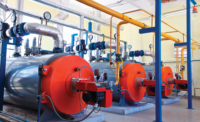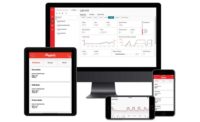Starbucks officially started offering a free guest Wi-Fi feature several years ago. And it is just a guess on my part, but I suspect many people utilizing this service at the coffeehouse did not need to be told what to do with the Wi-Fi connection.
It was inherently known once connected that they could shop online, read a book, watch a YouTube video or just surf the Web. This feature has advantages and benefits but it is up to the user to define the use of the Feature to attain the Advantages and Benefits (FAB).
While maybe not inherently known to the end-user, boilers currently on the market also have features that can attain advantages and benefits.
The next generation boilers are now entering the market with remote connectivity. It’s worthwhile to talk about the FAB’s of this new feature so when you see remote connectivity on a glossy sales brochure, you have an advanced understanding of what can be accomplished without even being on the jobsite. Remote connectivity now provides access to the FAB’s of a boiler with a wired or wireless connection.
The ability to log into a boiler and see its current status is a powerful tool. An engineer can view the current outdoor air temperature at that location, as well as track the target reset temperature when there is a call for heat and outdoor reset (OD) is being utilized (see Figure 1).
The remote connectivity feature also allows for the adjustment of the OD reset schedule via the min/max outdoor temps and min/max setpoints. This can be accomplished via a smartphone and provides instant feedback (visually) on how the reset schedule is set up. The ability to log in and groom three independent outdoor reset schedules is a feature that will not intimidate veteran installers who may have previously shied away from programming (see Figure 2).
What if there is an installation that is a few hours away and an engineer or installer wants to know at a glance if it is running as designed or conversely if it is experiencing short-cycling issues? They can now view the runtime history feature.
Figure 3shows the total number of ignition attempts and compares it with the runtime hours. Figure 3 also illustrates that the boiler has responded to a call for heat 110 times and successfully ignited 109. (Initial startup with an unpurged natural gas line caused an unsuccessful attempt.) With 1,304 runtime hours, that equates to 11.96 hours of runtime per ignition attempt. This is another example of a feature with the immediate benefit of knowing this boiler is experiencing very healthy runtimes and is not cycling more than six times an hour. This is a clear advantage in diagnostics when you have the ability to monitor, diagnose and correct short cycling in heating systems.
Another feature in the next generation of FABs is high-mass heat exchangers. When using the word mass, let’s make that synonymous with volume. There are modulating-condensing boilers in the market today with very small mass and some with high mass.
What benefits and advantages are there for high-mass heat exchangers? The answer is the ability to cycle less frequently than an equal Btu boiler with a low-mass heat exchanger.
Generally speaking, manufacturers of modulating-condensing boilers have somewhat plateaued with common FABs. Companies are producing equipment with efficiencies in the mid- to high 90% range.
Think about a low-mass heat emitter such as a hot-water coil residing in an air handler (Figure 4). This low-water content emitter can be further controlled as variable flow. Low-flow requirements with low-water content present the potential for short cycling.
Assuming these conditions, adding thermal mass to a system can offset the potential for short cycling. To dig a little deeper, if there is an 800,000 Btu/hr. boiler with a low-water content heat exchanger, the unit can modulate down to its lowest possible firing rate. If the lowest firing rate is still above the current load, then the boiler will achieve its set point and shut the flame off in the boiler even though the load has not satisfied. Adding more volume to this equation will allow the boiler the opportunity to run for a longer time. But please keep in mind the aforementioned runtime history with the remote connectivity feature.
Prior to high-mass heat exchangers, one option for system designers would be to add a buffer tank piped into the system as a thermal flywheel. The tank absorbs the Btu generated from the boiler while at its lowest firing rate. There is a larger load to absorb and redistribute the Btu. Think about the math involved in sizing a buffer tank.
The minimum firing rate of the boiler is the minimum load required of the heat emitter, the Delta-T and a cycle time selected by the designer. It is common to see a 10-minute cycle time for initial design. The size of the buffer tank can be calculated from these variables.
If engineers use the volume of the heat exchanger as a fixed variable for volume and all other variables remain constant, they now can extract a cycle time.
Here is what that would look like with a low-mass 800,000 Btu/hr. boiler with a minimum firing rate of 160,000 Btu/hr., or 5:1 turndown with an arbitrary load of 40,000 Btu/hr., for this heat emitter (Qload) operating at a 30° F Delta-T. An engineer can select any part-load condition he or she wants, but this is a selection of a simple load that is a fraction of the boiler’s minimum firing rate. In this instance, the formula would calculate the need for an 80-gal. buffer tank.
In Figure 5, use the same math but use the high mass of the heat exchanger as the volume and now calculate for a cycle time.
For this example, use a 400,000 Btu/hr. (input) boiler with a high-mass heat exchanger. This boiler features low fire (Qhs) at 39,200 Btu/hr., (10:1 turndown) and a heat-exchanger volume of 11.9 gal. Use a 25,000 Btu/hr. Qload and now solve for time.
The benefits of a boiler system that is not short-cycling is higher efficiency, less wear-and-tear on components, and a better life-cycle cost that is in the best interest of the end-user and installer.
The next generation of feature, advantages and benefits are out there. Now, just like Wi-Fi at Starbucks, an engineer will not need to be told how best to utilize these FABs.
This article was originally titled “The new wave” in the January 2016 print edition of PM Engineer.








